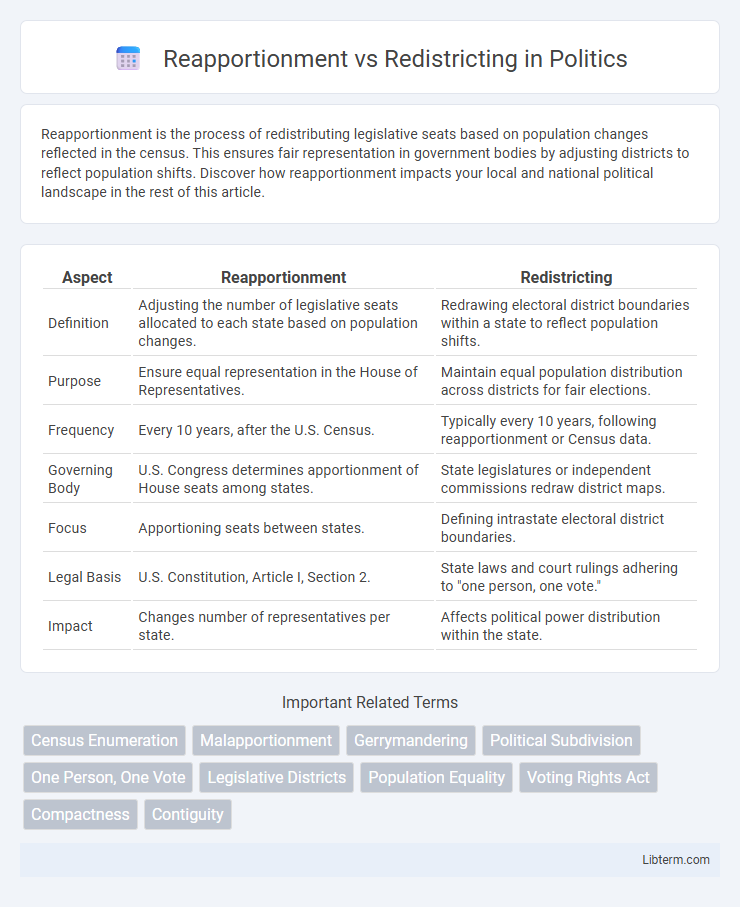Reapportionment is the process of redistributing legislative seats based on population changes reflected in the census. This ensures fair representation in government bodies by adjusting districts to reflect population shifts. Discover how reapportionment impacts your local and national political landscape in the rest of this article.
Table of Comparison
| Aspect | Reapportionment | Redistricting |
|---|---|---|
| Definition | Adjusting the number of legislative seats allocated to each state based on population changes. | Redrawing electoral district boundaries within a state to reflect population shifts. |
| Purpose | Ensure equal representation in the House of Representatives. | Maintain equal population distribution across districts for fair elections. |
| Frequency | Every 10 years, after the U.S. Census. | Typically every 10 years, following reapportionment or Census data. |
| Governing Body | U.S. Congress determines apportionment of House seats among states. | State legislatures or independent commissions redraw district maps. |
| Focus | Apportioning seats between states. | Defining intrastate electoral district boundaries. |
| Legal Basis | U.S. Constitution, Article I, Section 2. | State laws and court rulings adhering to "one person, one vote." |
| Impact | Changes number of representatives per state. | Affects political power distribution within the state. |
Understanding Reapportionment: Definition and Purpose
Reapportionment is the process of redistributing seats in the U.S. House of Representatives among the states based on changes in population determined by the decennial census. Its primary purpose is to ensure equitable representation by adjusting the number of congressional districts a state is allocated according to population shifts. This adjustment aims to maintain proportional representation in the federal legislature, reflecting demographic changes over the ten-year period.
What is Redistricting? A Comprehensive Overview
Redistricting is the process of redrawing the boundaries of electoral districts to reflect population changes identified by the decennial census. It ensures equal representation by adjusting district lines so that each has approximately the same number of constituents. State legislatures or independent commissions typically conduct redistricting, affecting local, state, and federal electoral districts.
Key Differences Between Reapportionment and Redistricting
Reapportionment involves the redistribution of the 435 seats in the U.S. House of Representatives among the 50 states based on decennial census population changes, impacting state representation at the federal level. Redistricting, on the other hand, is the process by which individual states redraw the boundaries of their congressional and state legislative districts to reflect population shifts within the state. The key difference lies in reapportionment's focus on how many seats each state receives, while redistricting determines the specific geographic boundaries within the states for electoral districts.
The Legal Framework Governing Reapportionment
The legal framework governing reapportionment is primarily anchored in the U.S. Constitution, particularly the Equal Protection Clause of the 14th Amendment, which mandates equal population distribution across legislative districts. Key Supreme Court cases like Baker v. Carr (1962) and Reynolds v. Sims (1964) established the principle of "one person, one vote," requiring states to conduct reapportionment to ensure equitable representation based on the decennial census data. Federal statutes, including the Voting Rights Act of 1965, further regulate reapportionment to prevent racial gerrymandering and protect minority voting rights during the redrawing of legislative boundaries.
The Redistricting Process: Step-by-Step
The redistricting process begins with analyzing the latest Census data to determine population changes and shifts. Next, legislative bodies or independent commissions develop new district maps, ensuring equal population distribution and compliance with the Voting Rights Act. Public input and legal review often follow before final approval and implementation of the new districts.
Political Impacts of Reapportionment and Redistricting
Reapportionment impacts political power by reallocating congressional seats based on population shifts from the decennial census, often altering the balance of representation among states and influencing federal resource distribution. Redistricting shapes electoral outcomes by redrawing district boundaries within states, which can lead to gerrymandering and affect party dominance at the local, state, and national levels. Both processes critically influence political strategy, voter engagement, and the effectiveness of representative democracy in the United States.
Reapportionment and Representation: Ensuring Equal Voice
Reapportionment adjusts the number of legislative seats allocated to each state based on population changes from the decennial census, ensuring equitable representation in the House of Representatives. This process prevents disproportionate influence by assigning seats according to updated demographic data, maintaining the principle of "one person, one vote." Effective reapportionment promotes equal political voice, balancing representation across diverse and shifting populations nationwide.
Common Challenges and Controversies in Redistricting
Redistricting often faces challenges such as gerrymandering, which manipulates district boundaries to favor specific political parties or groups, undermining fair representation. Legal battles frequently arise due to disputes over racial or partisan biases embedded in district maps, leading to prolonged court interventions. Public distrust and accusations of political abuse are common controversies, complicating efforts to create equitable districts.
Technology’s Role in Modern Reapportionment and Redistricting
Advancements in Geographic Information Systems (GIS) and data analytics have revolutionized reapportionment and redistricting by enabling precise mapping of population changes and voter demographics. Sophisticated algorithms and AI tools help create equitable districts by minimizing gerrymandering and enhancing transparency in the redistricting process. Real-time census data integration allows for dynamic adjustments, ensuring political boundaries reflect current population distributions accurately.
Future Trends and Reforms in Both Processes
Future trends in reapportionment emphasize enhanced accuracy through the integration of advanced demographic analytics and real-time population data, improving legislative representation equity. Redistricting reforms focus on increasing transparency and reducing partisan gerrymandering by adopting independent commissions and algorithm-driven boundary drawing. Both processes are moving toward greater public accountability and technological innovation to ensure fairer and more representative electoral maps.
Reapportionment Infographic

 libterm.com
libterm.com